engine OPEL CORSA 2009 Owner's Guide
[x] Cancel search | Manufacturer: OPEL, Model Year: 2009, Model line: CORSA, Model: OPEL CORSA 2009Pages: 284, PDF Size: 4.96 MB
Page 145 of 284
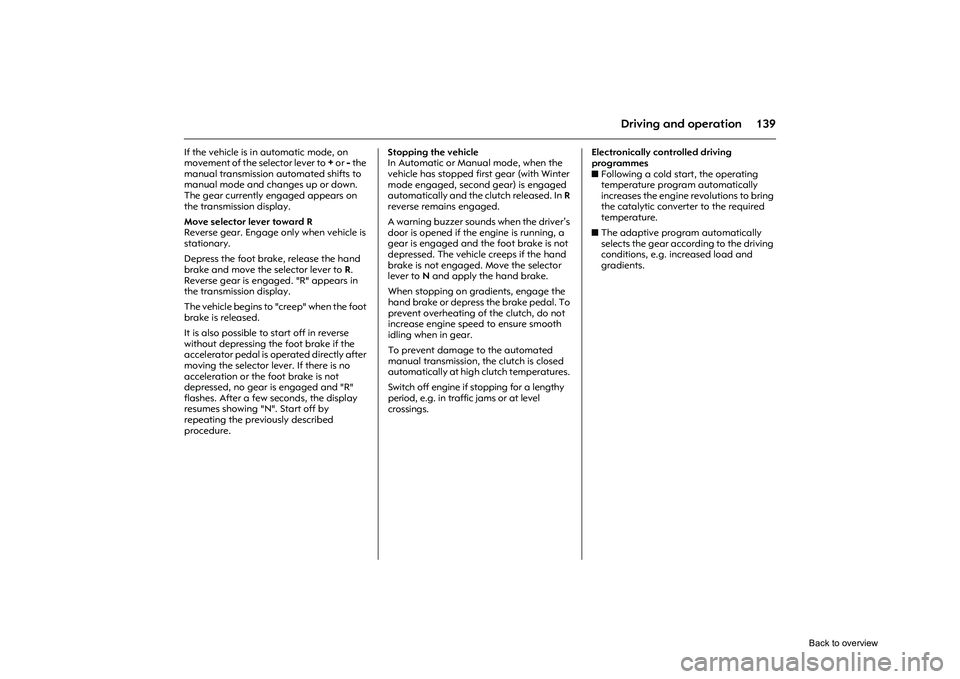
139
Driving and operation
If the vehicle is in automatic mode, on
movement of the selector lever to
+ or
- the
manual transmission automated shifts to
manual mode and changes up or down.
The gear currently engaged appears on
the transmission display.
Move selector lever toward R
Reverse gear. Engage only when vehicle is
stationary.
Depress the foot brake, release the hand
brake and move the selector lever to R.
Reverse gear is engaged. "R" appears in
the transmission display.
The vehicle begins to "creep" when the foot
brake is released.
It is also possible to start off in reverse
without depressing the foot brake if the
accelerator pedal is operated directly after
moving the selector lever. If there is no
acceleration or the foot brake is not
depressed, no gear is engaged and "R"
flashes. After a few seconds, the display
resumes showing "N". Start off by
repeating the previously described
procedure. Stopping the vehicle
In Automatic or Manual mode, when the
vehicle has stopped first gear (with Winter
mode engaged, second gear) is engaged
automatically and the clutch released. In
R
reverse remains engaged.
A warning buzzer sounds when the driver’s
door is opened if the engine is running, a
gear is engaged and the foot brake is not
depressed. The vehicle creeps if the hand
brake is not engaged. Move the selector
lever to N and apply the hand brake.
When stopping on gradients, engage the
hand brake or depress the brake pedal. To
prevent overheating of the clutch, do not
increase engine speed to ensure smooth
idling when in gear.
To prevent damage to the automated
manual transmission, the clutch is closed
automatically at high clutch temperatures.
Switch off engine if stopping for a lengthy
period, e.g. in traffic jams or at level
crossings. Electronically controlled driving
programmes
z
Following a cold start, the operating
temperature program automatically
increases the engine revolutions to bring
the catalytic converter to the required
temperature.
z The adaptive program automatically
selects the gear according to the driving
conditions, e.g. increased load and
gradients.
Back to overview
Page 146 of 284
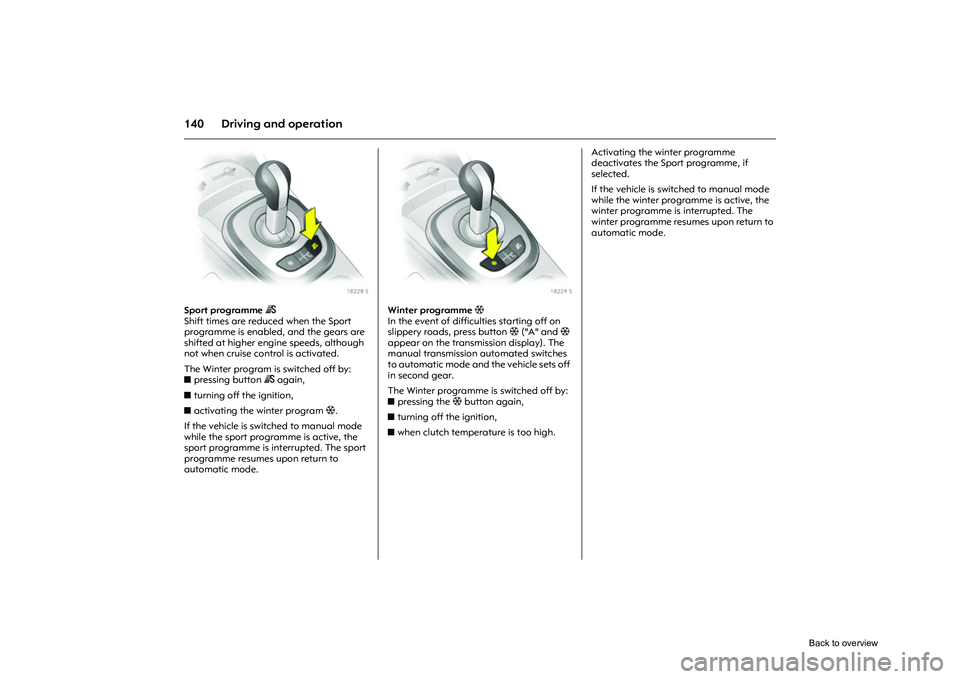
140 Driving and operation
Picture no: 18228s.tif
Sport programme =
Shift times are reduced when the Sport
programme is enabled, and the gears are
shifted at higher engine speeds, although
not when cruise control is activated.
The Winter program is switched off by:
z pressing button = again,
z turning off the ignition,
z activating the winter program T .
If the vehicle is switched to manual mode
while the sport programme is active, the
sport programme is in terrupted. The sport
programme resumes upon return to
automatic mode.
Picture no: 18229s.tif
Winter programme T
In the event of difficulties starting off on
slippery roads, press button T ("A" and T
appear on the transmission display). The
manual transmission automated switches
to automatic mode and the vehicle sets off
in second gear.
The Winter programme is switched off by:
z pressing the T button again,
z turning off the ignition,
z when clutch temperature is too high. Activating the winter programme
deactivates the Sport programme, if
selected.
If the vehicle is switched to manual mode
while the winter prog
ramme is active, the
winter programme is interrupted. The
winter programme resumes upon return to
automatic mode.
Back to overview
Page 147 of 284

141
Driving and operation
Picture no: 18451s.tif
Kickdown
If the accelerator pedal is pressed past the
pressure point, the transmission shifts to a
lower gear depending on engine speed.
During kickdown no manual gear shifting is
possible. When the engine speed approaches its
upper limit, the transmission shifts to a
higher gear during kickdown even in
Manual mode.
Without kickdown this automatic shift is
not effected in Manual mode.
If the SPORT programme is engaged, the
driven wheels may spin slightly when
starting off with kickdown. This allows for
maximum acceleration of the vehicle.
Engine braking
Automatic mode
When driving downhill, the manual
transmission automated does not shift into
higher gears until a fairly high engine
speed has been reached. When braking,
the manual transmission automated shifts
down in good time.
Manual modeTo utilise the engine braking effect, select a
lower gear in good time when driving
downhill. "Rocking the car"
Move selector lever between
R and A
(or + or -) while applying light pressure to
the accelerator pedal ONLY if the vehicle
has to be rocked to free it from sand, mud,
snow or a hole. Do not race the engine and
avoid sudden acceleration.
Back to overview
Page 148 of 284
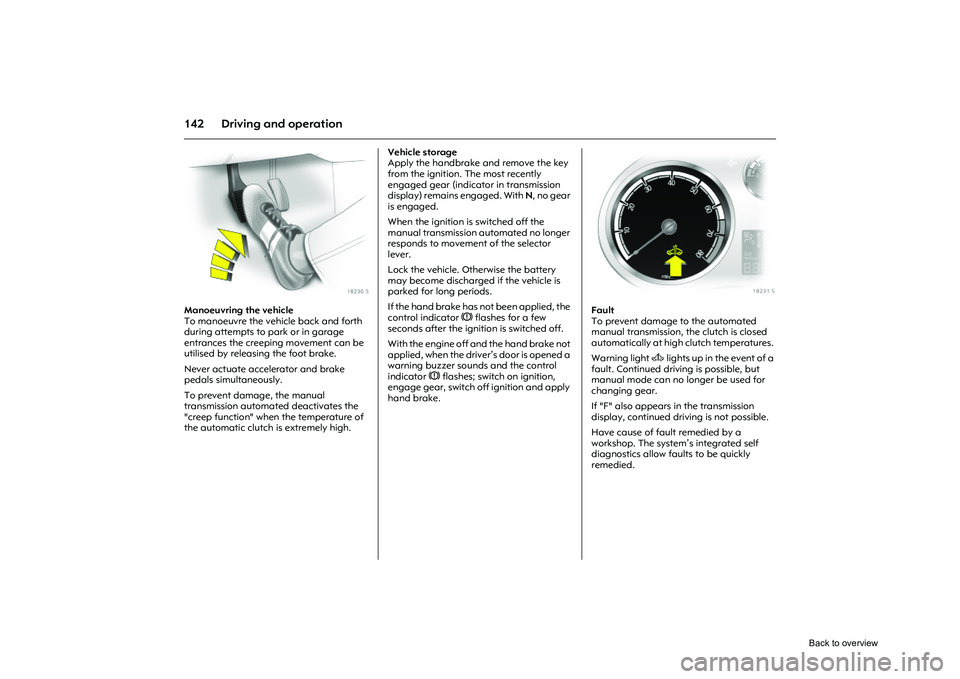
142 Driving and operation
Picture no: 18230s.tif
Manoeuvring the vehicle
To manoeuvre the vehicle back and forth
during attempts to park or in garage
entrances the creeping movement can be
utilised by releasing the foot brake.
Never actuate accelerator and brake
pedals simultaneously.
To prevent damage, the manual
transmission automated deactivates the
"creep function" when the temperature of
the automatic clutch is extremely high. Vehicle storage
Apply the handbrake and remove the key
from the ignition. The most recently
engaged gear (indicator in transmission
display) remains engaged. With
N, no gear
is engaged.
When the ignition is switched off the
manual transmission automated no longer
responds to movement of the selector
lever.
Lock the vehicle. Otherwise the battery
may become discharged if the vehicle is
parked for long periods.
If the hand brake has not been applied, the
control indicator R flashes for a few
seconds after the ignition is switched off.
With the engine off and the hand brake not
applied, when the driver ’s door is opened a
warning buzzer sounds and the control
indicator R flashes; switch on ignition,
engage gear, switch off ignition and apply
hand brake.
Picture no: 18231s.tif
Fault
To prevent damage to the automated
manual transmission, the clutch is closed
automatically at high clutch temperatures.
Warning light A lights up in the event of a
fault. Continued driving is possible, but
manual mode can no longer be used for
changing gear.
If "F" also appears in the transmission
display, continued driving is not possible.
Have cause of fault remedied by a
workshop. The system’s integrated self
diagnostics allow faults to be quickly
remedied.
Back to overview
Page 149 of 284
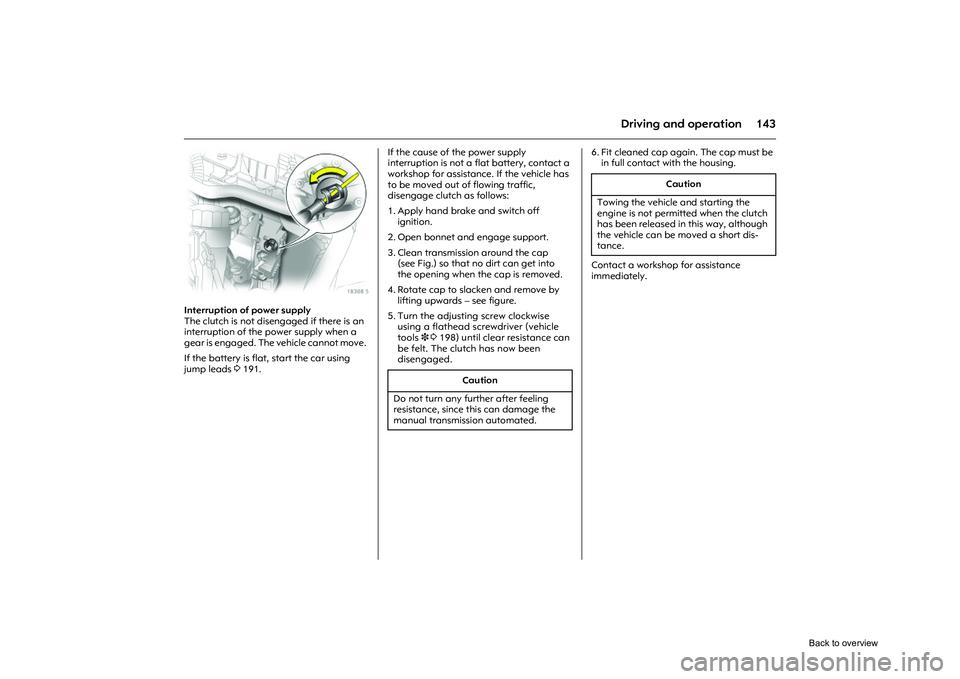
143
Driving and operation
Picture no: 18308s.tif
Interruption of power supply
The clutch is not disengaged if there is an
interruption of the power supply when a
gear is engaged. The vehicle cannot move.
If the battery is flat, start the car using
jump leads 3191. If the cause of the power supply
interruption is not a flat battery, contact a
workshop for assistance. If the vehicle has
to be moved out of flowing traffic,
disengage clutch as follows:
1. Apply hand brake and switch off
ignition.
2. Open bonnet and engage support.
3. Clean transmission around the cap (see Fig.) so that no dirt can get into
the opening when the cap is removed.
4. Rotate cap to slacken and remove by lifting upwards – see figure.
5. Turn the adjusting screw clockwise using a flathead screwdriver (vehicle
tools 3 3198) until clear resistance can
be felt. The clutch has now been
disengaged. 6. Fit cleaned cap again. The cap must be
in full contact with the housing.
Contact a workshop for assistance
immediately.
Caution
Do not turn any further after feeling
resistance, since this can damage the
manual transmission automated.
Caution
Towing the vehicle and starting the
engine is not permitted when the clutch
has been released in this way, although
the vehicle can be moved a short dis-
tance.
Back to overview
Page 151 of 284
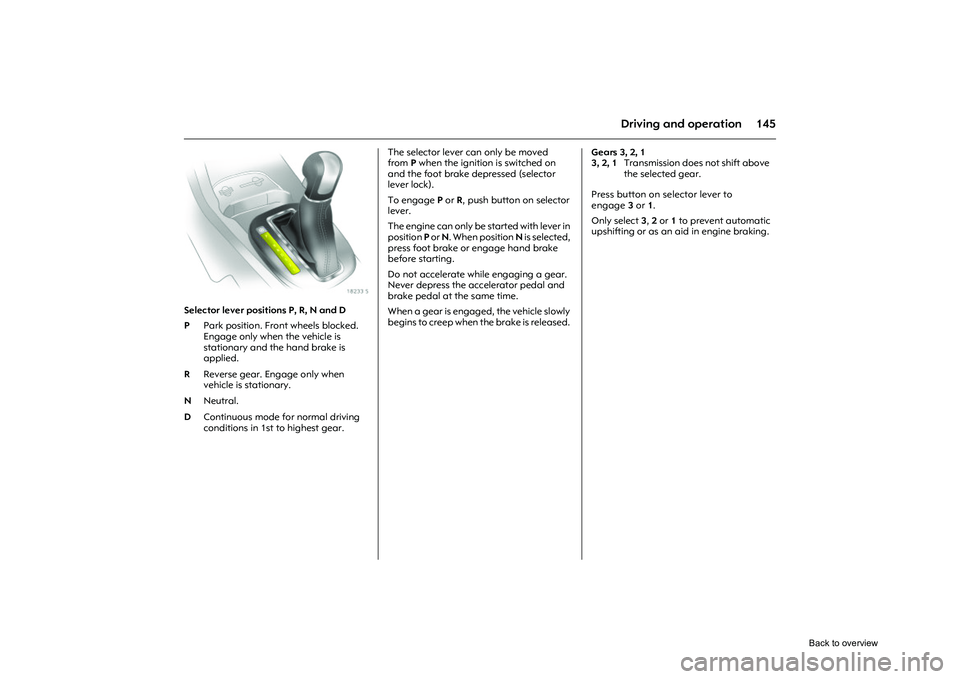
145
Driving and operation
Picture no: 18233s.tif
Selector lever positions P, R, N and D The selector lever can only be moved
from
P when the ignition is switched on
and the foot brake depressed (selector
lever lock).
To engage P or R, push button on selector
lever.
The engine can only be started with lever in
position P or N . When position N is selected,
press foot brake or engage hand brake
before starting.
Do not accelerate while engaging a gear.
Never depress the accelerator pedal and
brake pedal at the same time.
When a gear is engaged, the vehicle slowly
begins to creep when the brake is released. Gears 3, 2, 1
Press button on selector lever to
engage
3or 1.
Only select 3, 2 or 1 to prevent automatic
upshifting or as an aid in engine braking.
P Park position. Fron t wheels blocked.
Engage only when the vehicle is
stationary and the hand brake is
applied.
R Reverse gear. Engage only when
vehicle is stationary.
N Neutral.
D Continuous mode for normal driving
conditions in 1st to highest gear.
3, 2, 1 Transmission does not shift above
the selected gear.
Back to overview
Page 152 of 284

146 Driving and operationElectronically controlled driving
programmes
zThe automatic neutral shift function
automatically shifts to idling when the
vehicle is stopped with a forward gear
engaged (depending on transmission
fluid temperature).
z Following a cold start, the operating
temperature programme increases
engine speed to quickly bring the
catalytic converter to the required
temperature.
z The adaptive program automatically
adjusts the gear change to the driving
conditions, e.g. greater load or gradients.
Picture no: 18234s.tif
Winter programme T
Activate the Winter pr ogramme if you have
problems starting off on a slippery road
surface.
To activate Press the T button with P , R , N , D or 3
engaged. The vehicle starts off in 3rd gear.
To deactivate The Winter programme is switched off by:
z pressing the T button again,
z manually selecting 2 or 1 ,
z turning off the ignition,
z or if the transmission oil temperature is
too high.
Picture no: 18451s.tif
Kickdown
If the accelerator pedal is pressed past the
pressure point, the transmission shifts to a
lower gear depending on engine speed.
Back to overview
Page 153 of 284

147
Driving and operation
Engine braking
In order to utilise the engine braking
effect when driving downhill, select drive
range 3,2 or, if necessary, 1 in good time.
Gear 1 has the greatest braking effect. If
gear 1 is selected at too great a speed
the transmission remains in 2nd until the
shifting point for 1st gear is achieved by
braking, for example.
"Rocking the car"
If it becomes necessary to rock the vehicle
to free it from sand, mud, snow or a hole,
move the selector lever from D to R
repeatedly. Do not race the engine and
avoid sudden acceleration.
Picture no: 18230s.tif
Manoeuvring the vehicle
To manoeuvre the vehicle back and forth
during attempts to park or in garage
entrances, the vehicle’s creeping
movement can be utilis ed by releasing the
brake pedal.
Never actuate accelerator and brake
pedals simultaneously. Stopping the vehicle
The selector lever can be left in the chosen
gear with the engine running.
When stopping on gr
adients engage hand
brake or depress brake pedal. To prevent
overheating of the transmission, do not
increase engine revolutions to ensure
smooth idling while standing if a gear has
been selected.
Switch off engine if stopping for a lengthy
period, e.g. in traffic jams or at level
crossings.
Before leaving the car, apply the hand
brake first, then select P. Remove the
ignition key. Lock the vehicle. Otherwise
the battery may become discharged if the
vehicle is parked for long periods.
The ignition key can only be removed when
the selector lever is in position P.
Back to overview
Page 155 of 284

149
Driving and operation
Driving hints The first 1000 km
Drive your vehicle at various speeds. Do
not use full throttle. Never allow the engine
to labour at low revs.
Make good use of all gears. Depress the
accelerator pedal a maximum of about
3/4
of the available pedal travel in all gears.
Do not drive faster than three quarters of
maximum speed.
Do not brake unnecessarily hard for the
first 200 km.
During the first drive smoke may develop
because of wax and oil evaporating on the
exhaust system. Park the vehicle in the
open for a while after the first drive and
avoid inhaling the fumes.
Fuel and engine oil consumption is higher
than normal during the running-in period.
Never coast with engine not running
Many units will not function in this situation
(e.g. brake servo unit, electro-hydraulic
power steering). Driving in this manner is a
danger to yourself and others. Brake servo unit
When the engine is not running, the brake
servo unit is no longer effective once the
brake pedal has been depressed once or
twice. Braking effect is not reduced, but
significantly greater force is required for
braking.
Electro-hydraulic power assisted steering
If the power assisted steering fails when
being towed with the engine switched off,
the vehicle can still be steered, but
considerably more force is required.
Driving in mountainous terrain or with a
trailer/caravan
The cooling fan is elec
trically operated. Its
cooling power is therefore independent of
the engine speed.
Since a considerable amount of heat is
generated at high engine speeds and less
at slower speeds, do not shift down when
climbing hills whilst the vehicle is still coping
with the gradient in the higher gear. Driving with a roof load
Do not exceed the permissible roof load
3
173, 3259. For reasons of safety,
distribute the load evenly and secure it
properly with retaining straps. Adjust tyre
pressure to load conditions. Do not drive
faster than 120 km/h. Check and re-tighten
the straps frequently. Observe country-
specific regulations.
Switching off the engine
When you switch off, fans in the engine
compartment may continue running for a
time to cool the engine.
If the engine temperature is very high, e.g.
after driving in mountainous terrain: allow
the engine to idle for approximately two
minutes in order to prevent heat
accumulation.
Vehicles with turbocharged engine
After running at high engine speeds or
high engine loads, operate the engine
briefly at a low load or run in neutral for
approx. 30 seconds befo re switching off
in order to protect the turbocharger.
Back to overview
Page 156 of 284
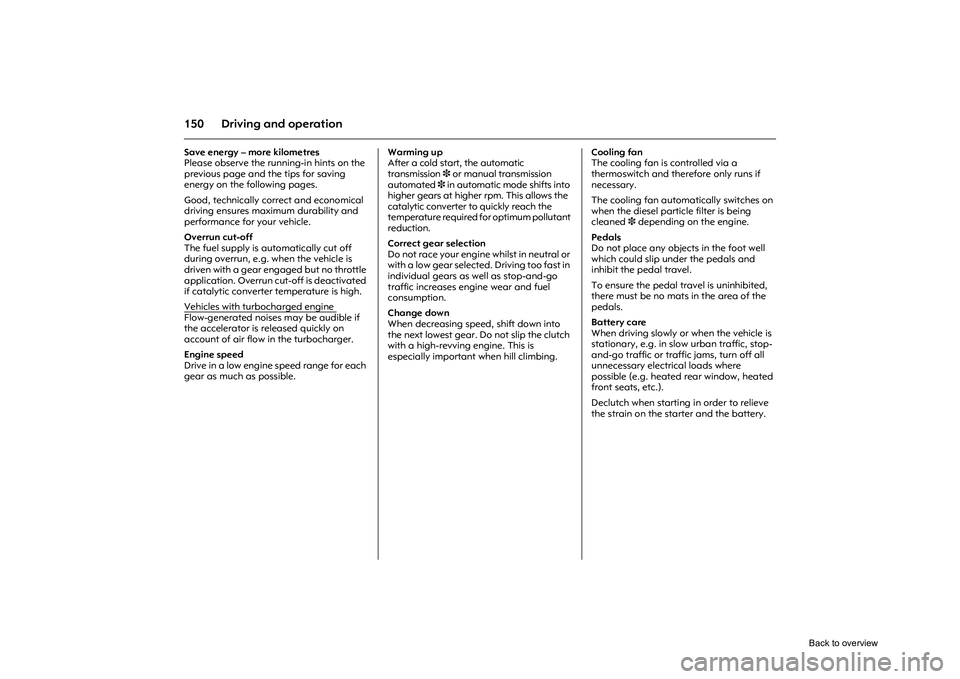
150 Driving and operationSave energy – more kilometres
Please observe the running-in hints on the
previous page and the tips for saving
energy on the following pages.
Good, technically correct and economical
driving ensures maximum durability and
performance for your vehicle.
Overrun cut-off
The fuel supply is automatically cut off
during overrun, e.g. when the vehicle is
driven with a gear engaged but no throttle
application. Overrun cut-off is deactivated
if catalytic converter temperature is high.
Vehicles with turbocharged engine Flow-generated noises may be audible if
the accelerator is released quickly on
account of air flow in the turbocharger.
Engine speed
Drive in a low engine speed range for each
gear as much as possible. Warming up
After a cold start, the automatic
transmission
3 or manual transmission
automated 3 in automatic mode shifts into
higher gears at higher rpm. This allows the
catalytic converter to quickly reach the
temperature required for optimum pollutant
reduction.
Correct gear selection
Do not race your engine whilst in neutral or
with a low gear selected. Driving too fast in
individual gears as well as stop-and-go
traffic increases engine wear and fuel
consumption.
Change down
When decreasing speed, shift down into
the next lowest gear. Do not slip the clutch
with a high-revving engine. This is
especially important when hill climbing. Cooling fan
The cooling fan is controlled via a
thermoswitch and therefore only runs if
necessary.
The cooling fan automatically switches on
when the diesel particle filter is being
cleaned
3 depending on the engine.
Pedals
Do not place any objects in the foot well
which could slip under the pedals and
inhibit the pedal travel.
To ensure the pedal travel is uninhibited,
there must be no mats in the area of the
pedals.
Battery care
When driving slowly or when the vehicle is
stationary, e.g. in slow urban traffic, stop-
and-go traffic or traffic jams, turn off all
unnecessary electrical loads where
possible (e.g. heated rear window, heated
front seats, etc.).
Declutch when starting in order to relieve
the strain on the starter and the battery.
Back to overview